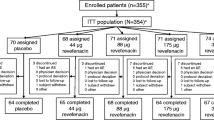Abstract
Twelve patients suffering from partially reversible chronic obstructive pulmonary disease (COPD) took past in a single blind, randomised, 4-way cross-over trial to determine the optimal dose and duration of action of the anticholinergic agent oxitropium bromide (OTB) inhaled as a nebulised solution.
Single doses of 500, 1000, 1500 and 2000 μg nebulised OTB were compared during a 6 hour-observation period. Lung function test results indicated that 500 and 100 μg OTB only induced slight bronchodilatation, whereas 1500 and 2000 μg OTB produced a significantly greater increase in mean FEV1 compared to 500 μg. There was a trend for 2000 μg to be superior to 1000 μg, but 2000 μg and 1500 μg were not significantly different. Significant bronchodilatation (>15% rise in FEV1 from baseline) persisted for 6 h after 1500 μg. A significant decrease in airway resistance (Raw) was observed following inhalation of 2000 μg. The mean decrease in Raw was 33% after 30 min, 20% after 4 h and 12% after 6 h.
In this trial, 2000 μg OTB administered by an ultrasonic nebuliser was the optimal dose, but a satisfactory result was also obtained with 1500 μg.
Similar content being viewed by others
References
Dharma AP (1979) Oxitropium bromide anticholinergic bronchodilator. Drugs Future 4: 117–121
Peel ET, Anderson G (1984) A dose response study of oxitropium bromide in bronchitis. Thorax 39: 453–456
Frith PA, Jenner B, Dangerfield R, Atkinson J, Drennan C (1986) Oxitropium bromide, dose-response and time-response study of a new anticholinergic bronchodilator drug. Chest 86: 249–253
Hay JG, Stone P, Carter J, Church S, Eyre Brook A, Pearson MG, Woodcock AA, Calverley PMA (1992) Bronchodilator reversibility, exercise performance and breathlessness in stable chronic obstructive pulmonary disease. Eur Respir J 5: 659–664
Coe CI, Barnes PJ (1986) Reduction of nocturnal asthma by an inhaled anticholinergic drug. Chest 90: 485–488
Bryant DH, Rogers P (1990) Oxitropium bromide: an acute dose response study of a new anticholinergic drug in combination with fenoterol in asthma and chronic bronchitis. Pulm Pharmacol 3: 55–58
Pavia D, Lopez-Vidriero MT, Agnew JE, Taylor RG, Eyrebrook A, Lawton WA, Pellow PGD, Clarke SW (1987) Effect of four weeks oxitropium bromide treatment on lung mucociliary clearance in patients with chronic bronchitis or asthma. Postgrad Med J 63: 15a
Nebulisers in the treatment of asthma (1987) Drug Ther Bull 25: 101–103
Newman SP (1988) Aerosol deposition considerations in inhalation therapy. Chest 88 [Suppl]: 152–160
Morley TF, Marozsan E, Zappasodi SJ, Gordon R, Griesback R, Giudice JC (1988) Comparison of Beta-adrenergic agents delivered by nebulizer vs metered dose inhaler with inspirease in hospitalized asthmatic patients. Chest 94: 1205–1210
Johnson CE (1989) Principles of nebulizer-delivered drug therapy for asthma. Am J Hosp Pharm 46: 1845–1855
Dorow P (1986) Dosis Wirkungsbeziehung der Oxitropiumbromid, Inhalationslösung bei Patienten mit chronisch obstruktiver Atemwegerkrankung. Dustri, Deisenhofen, pp 83–102
American Thoracic Society (1962) Chronic bronchitis, asthma and pulmonary emphysema. Am Rev Respir Dis 85: 762–768
Author information
Authors and Affiliations
Rights and permissions
About this article
Cite this article
Stappaerts, I., Van Schil, L. & Van der Veken, J. Dose-response study of oxitropium bromide inhaled as a nebulised solution. Eur J Clin Pharmacol 46, 305–307 (1994). https://doi.org/10.1007/BF00194396
Received:
Accepted:
Issue Date:
DOI: https://doi.org/10.1007/BF00194396




